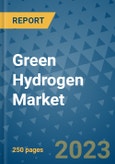Increasing Awareness of Green Hydrogen as an Alternative to Fossil Fuels Drives Market Expansion
The global green hydrogen market is set to experience remarkable growth, with a projected Compound Annual Growth Rate (CAGR) of 17.8% between 2023 and 2030. By the end of the forecast period, the market is expected to reach an estimated value of approximately US$25.4 billion. This surge in demand for green hydrogen comes as nations worldwide intensify their efforts to combat climate change and transition to cleaner and more sustainable energy sources.
Key Report Findings
The green hydrogen market is anticipated to surpass the US$25 billion mark by the end of the forecast period. Currently, over 90% of global hydrogen production is derived from grey hydrogen, but the market is shifting towards green hydrogen production due to declining costs of renewable energy sources, reducing electrolyzer costs, and technological advancements. In 2022, the refining sector accounted for more than 61% of the market share, with alkaline electrolyzers making up over 52% of the technology segment. Solar PV technology held a dominant share of more than 53% in 2022. Asia Pacific currently leads the market, closely followed by Europe.
Market Drivers
Growing Awareness About Green Hydrogen as a Potential Alternative to Fossil Fuel and Grey Hydrogen
Public understanding of hydrogen as a clean energy carrier is increasing, with hydrogen fuel cells offering high efficiency and minimal greenhouse gas emissions. Hydrogen-based fuel cells have the potential to generate electricity with up to 60% efficiency, compared to traditional combustion-based power plants with an efficiency of 33-35%. This increased awareness and efficiency are expected to drive the adoption of green hydrogen, fueling market growth.
Favorable Perception as a Strong Medium to Achieve Net Zero Carbon Emission Goals
Numerous public campaigns and events focused on raising awareness about climate change have gained traction, garnering support from influential individuals and organizations advocating for cleaner technology adoption. Businesses are also actively investing in greener hydrogen technologies that are more efficient and capable of replacing conventional energy sources. This positive perception is expected to drive market expansion.
Market Challenges
Expensive Production Costs
The initial setup costs associated with green hydrogen production, storage, conversion, and transportation, as well as the ongoing maintenance of necessary infrastructure, pose significant challenges to market growth. However, increased investments and ongoing research and development projects aimed at cost-effective production technologies are expected to mitigate these challenges.
The COVID-19 Impact
The COVID-19 pandemic disrupted global supply chains and operations, affecting multiple industries, including the green hydrogen market. While the market has since recovered, the pandemic had a temporary impact on its growth trajectory.
Overview of Key Segments
Refining Application Dominates, But May See a Decrease by 2030
In terms of application, the global green hydrogen market is divided into refining, ammonia, transport, and others. In 2022, refining accounted for 61.3% of the market share, but this share is expected to gradually decline over the next seven years. Transport and other segments, including iron and steel and chemical industries, are expected to gain market share.
Preference for PEM Electrolyzer Expected to Grow Strong by 2030
In terms of technology, the market includes alkaline electrolyzers, PEM electrolyzers, and solid oxide electrolyzers, among others. In 2022, alkaline electrolyzers constituted 52.4% of the market share, which is expected to decrease gradually. PEM electrolyzers are projected to gain market share by 2030 due to their high-purity hydrogen production and ease of cooling.
Solar PV Source to Maintain Dominance Until 2030
Solar PV technology dominated the global green hydrogen market in 2022, accounting for 53.8% of the share. Solar power is highly favored for electrolyzer operations, especially in regions with high solar intensity. Ongoing and planned projects are expected to further boost the use of solar energy for green hydrogen production, with the solar PV segment projected to maintain strong growth with a CAGR of 17.9% by value until 2030.
Growth Opportunities Across Regions
Europe to Witness Strong Growth in Production and Consumption
Currently, Asia Pacific leads the global green hydrogen market, followed closely by Europe. China dominates the Asian market, accounting for over 60% of the share in 2022. India has initiated numerous green hydrogen pilot projects with the goal of achieving 8 million tons of green hydrogen capacity by 2030. In Europe, apart from refining and ammonia applications, strong growth is expected in the primary metal sector, particularly steel production, where green hydrogen is being used to create "green steel" by replacing fossil fuels.
North America Benefits from Favorable Clean Energy Legislation
The United States dominates the North American green hydrogen market in 2022, with several new green hydrogen projects set to commence in 2023. Canada is home to a significant 20 GW PEM electrolyzer plant, while the region is witnessing the implementation of clean energy legislation. Asia Pacific markets, particularly Canada and Australia, are expected to experience the highest CAGR, with significant contributions to the green hydrogen market expansion.
Green Hydrogen Market: Competitive Landscape
Key players in the global green hydrogen market include FuelCell Energy, Inc., Adani Green Energy, Bloom Energy Corporation, Linde Plc, Royal Dutch Shell, Plug Power, Inc., Air Products & Chemicals Inc., Air Liquide S.A., Reliance Industries, TotalEnergies, and BP p.l.c.
Table of Contents
Companies Mentioned
- FuelCell Energy, Inc.
- Adani Green Energy
- Bloom Energy Corporation
- Linde Plc
- Royal Dutch Shell
- Plug Power, Inc.
- Air Products & Chemicals Inc.
- Air Liquide S.A.
- Reliance Industries
- TotalEnergies
- BP
Methodology

LOADING...








